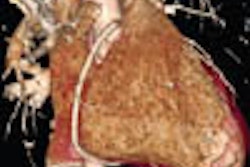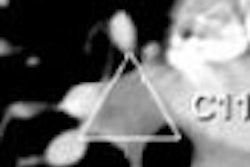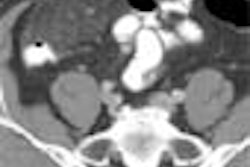Differences in overranging, also known as z overscanning, can lead to significant variations in radiation dose delivered by different multidetector CT scanners.
A new report from Holland concludes that the phenomenon is specific to scanner models and reconstruction algorithms, and that the "substantial but unnoticed" radiation dose is worth taking steps to avoid.
Overranging is an integral part of helical multidetector-row CT (MDCT), explained Dr. Aart van der Molen and Jacob Geleijns, Ph.D., from the Leiden University Medical Center in the Netherlands.
"Because in helical scan mode the reconstruction algorithm requires additional raw data on both sides of the planned scan, extra rotations outside the planned length are needed for image reconstruction," they wrote. "To enable reconstructions with both thin and thick section widths from the same raw data, the choice of reconstruction parameters also plays a role. Both factors will lead to exposure of tissue volumes above and below the planned length. This adds to the radiation dose to the patient and is therefore important for accurate dose calculations" (Radiology, January 2007, Vol. 242:1, pp. 208-216).
The evolution of CT scanners is to blame for the increased variability. In single-slice scanners, the number of overrange rotations is well-known (1.0 and 2.0 for the 180º and 360º linear interpolation algorithms, respectively), while in MDCT, image reconstruction algorithms are more variable and specific to the scanner model.
"With wider beam collimations in the newest scanners, the additional length from overranging and its relative contribution radiation dose may increase accordingly if its contribution outweighs the improved geometric dose efficiency of those scanners," van der Molen and Geleijns wrote.
The number of overrange rotations comes from two factors: first, that the scanner adds one section width to the prescribed scan length "because the planned scan positions define the center position of the first and last section to be reconstructed in all scanners." The remaining extra rotations come from the need to generate sufficient raw data to reconstruct the first and last sections, they explained.
The study aimed to quantify the number of overrange rotations on four 16-detector-row scanners, and assess their relative contributions to organ and effective doses. For purposes of the study, overranging was defined as the difference between the planned length and exposed length. The effect can be expected to be even greater in 64-row machines.
The four 16-slice scanners models used were the LightSpeed 16 with version 4.1 software (GE Healthcare, Chalfont St. Giles, U.K.), an MX 8000IDT scanner with version 2.5 software (Philips Medical Systems, Andover, MA), a Sensation 16 scanner with version VA60B software (Siemens Medical Solutions, Malvern, PA), and an Aquilion 16 scanner equipped with version 1.4 software (Toshiba America Medical Systems, Tustin, CA).
Overranging was quantified by means of free-in-air dose measurements applied at different scan lengths, according to the authors. The overrange rotations and lengths at a given scan width were extrapolated to determine the values for all pitches and section widths used clinically, with a separate analysis of the effect of different reconstruction widths.
The results were applied to clinical protocols for chest and abdominal imaging. Then the relative dose contributions of overranging to the organ and effective doses were derived from the established effective dose, as well as thyroid and testicular dose values.
"The thyroid and testicles were selected as radiosensitive indicator organs at the borders of the planned scans for chest and abdominal CT, respectively," the authors wrote.
The statistical analysis focused on the correlation of overranging rotations and lengths with scan collimations, pitch and section width, and the dose with and without overranging.
"Dose measurements with increasing planned length expressed in the number of tube rotations showed an almost perfect linear relationship for all scanners," they reported.
The number of overrange rotations showed considerable differences between scanners, ranging from 1.99 (GE: 0.56 pitch) to 4.04 (Siemens: 0.50 pitch) at the lowest available pitch, and at the highest pitch from 0.93 (GE: 1.75 pitch) to 2.59 (Toshiba: 1.44 pitch).
The number of rotations correlated negatively with pitch (r values, -0.92 to -0.99). When the number of rotations was converted to lengths, the overrange length correlated positively with pitch (r values, 0.95 to 1.00) and collimation (r values, 0.84 to 0.95; 95% CIs: 0.09, 0.98 to 0.74, 0.99) due to higher table feed at increased pitch values. (Collimation ranged from 1.0 to 1.5, and the reconstruction width for primary image reconstruction was 5 mm.) Overrange lengths were constant only for the Philips scanner at 0.75-mm collimation, possibly due to differences in the reconstruction algorithm between 0.75- and 1.5-mm collimation.
The effects of section length on overranging were variable, van der Molen and Geleijns reported.
"With increasing section width, the number of overrange rotations increased linearly (minimum r = 0.91 and 95% CI: 0.56, 0.98 for Siemens scanner; minimum r = 1.00 and 95% CI: 0.87, 1.00 for Toshiba scanner), decreased linearly (minimum r = -0.99 and 95% CI: -1.00, -0.84 for Philips scanner) or showed a nonlinear increasing relationship (minimum r = 0.06 and 95% CI: -0.87, 0.89 for GE Healthcare scanner)," they wrote. "The sharp increase in the number of rotations for the Siemens scanner was due to the fact that two reconstruction modes were used: (a) a slower conebeam-corrected mode at a smaller section width (compared with scan collimation) in which the number of overrange rotations was independent of section width, and (b) a faster z-filtering algorithm for a larger section width in which there was a gradual increase in the number of overrange rotations with increasing section width."
In the protocols, the overrange length ranged from 3.2 cm to 5.8 cm for the chest, and from 3.2 cm to 5.2 cm for the abdominal exams.
When the dose contribution of overranging was not accounted for, the values were significantly lower for thyroid (p = 0.012) and testicular (p = 0.025) doses and effective doses for chest (p = 0.005) and abdominal (p = 0.011) CT exams, they noted.
"We found variable numbers of overrange rotations for comparable scan collimations between scanners," the authors wrote. "With an increase in pitch, the number of overrange rotations decreases, with larger decreases in low pitch ranges than in high pitch ranges. At higher pitches, the decreased number of rotations does not outweigh the higher table feeds, so for all scanners, overrange length increased with increasing pitch and collimation. A small (0.5- to 0.75-mm) collimation with a high pitch had a more favorable overrange length than did a larger (1.0- to 2.0-mm) collimation with a lower pitch. A large variability was also demonstrated as an effect of increasing reconstructed section width for a constant planned length, supporting the conclusion that overranging is scanner-specific."
Overranging should be accounted for when creating CT protocols, especially those that call for short scan lengths and fast scanning with high collimation and pitch settings, the team advised.
"Overrange length can be minimized by scanning at the thinnest collimation and low pitch," the authors wrote, "while section width effects can be minimized by selecting a minimum section width for the first reconstruction and creating thick sections with thin-slab multiplanar reformation." Also, technicians should set boundaries judiciously when prescribing scans, a practice commonly overlooked in multisection scanning.
The effects will be even more significant in 64-slice scanners, which further increase detector widths and scan speeds, they predicted.
"This effect may be more important than the slightly improved dose efficiency in the imaged area that is achievable with 64-section scanners as compared with 16-section scanners. Future comparative studies will be needed to define these relative contributions," they noted.
Overranging depends on the scanning parameters and is scanner-specific, van der Molen and Geleijns concluded, contributing "substantially to doses in sensitive organs at the borders of the planned scan and thus to effective dose."
By Eric Barnes
AuntMinnie.com staff writer
February 1, 2007
Related Reading
64-slice CT takes on dual-source in cardiac radiation dose, January 26, 2007
ACC studies examine CTA radiation dose, March 17, 2006
Scores of detector rows bring opportunities, challenges to CT imaging, April 8, 2005
High pitch, thin sections can optimize MDCT protocols, August 22, 2003
Copyright © 2007 AuntMinnie.com



















